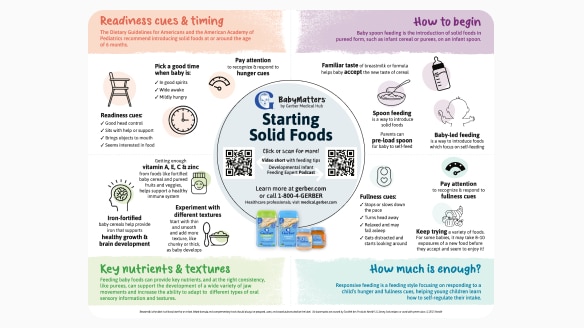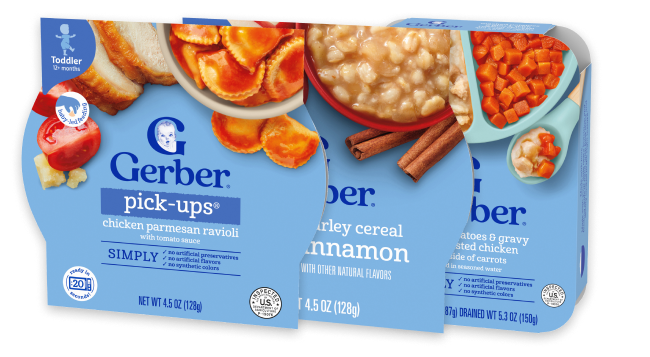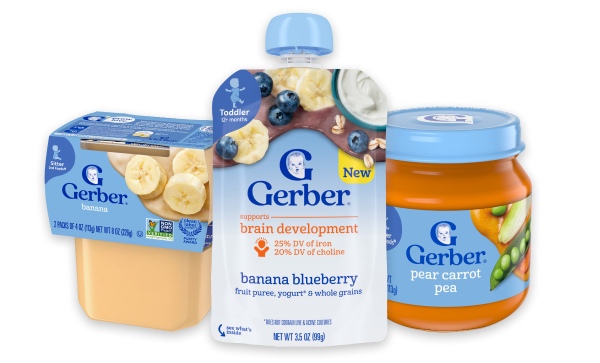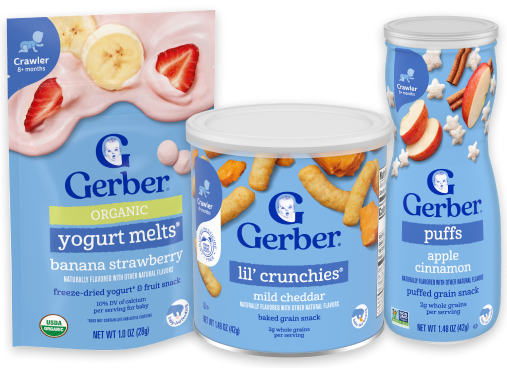Nutritious Gerber Infant Cereal Options
Gerber Infant Cereals are fortified to deliver essential nutrients to support healthy growth and development – importantly iron, zinc and B vitamins. Our infant cereals are made from a variety of wholesome grains, fruits, veggies and even legumes to help make every bite count in the infant diet. Gerber infant cereals grow with babies to be developmentally appropriate from starting solids through the first year and beyond, to help ensure infants get enough of key nutrients during this critical period of development.
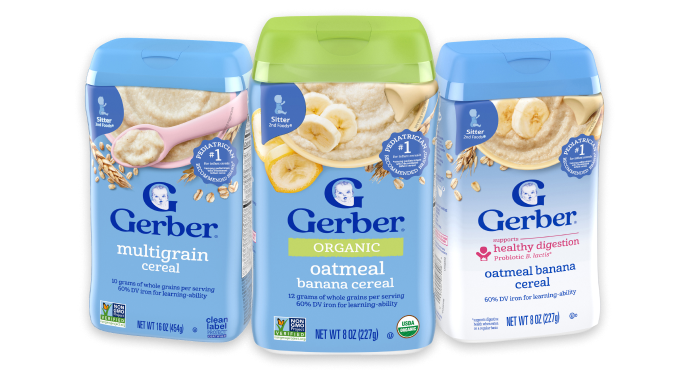
Role of Nutritious Gerber Infant Cereal Options in the Diet
Infant Cereal is the Top Food Source of Iron for Infants 6-12 Months
The Dietary Guidelines of Americans and American Academy of Pediatrics recommend infant cereal as an important source of iron from 6 to 12 months.
Recommended in the Dietary Guidelines as a Source of Iron and Zinc for Breastfed Infants
The Dietary Guidelines of Americans and American Academy of Pediatrics recommend infant cereal as an important source of iron from 6 to 12 months.
Adequate Intakes of Essential Nutrients is Critical
Being adequately nourished in iron and other key nutrients, also provided by infant cereal, can help protect against the effects of heavy metal exposure.
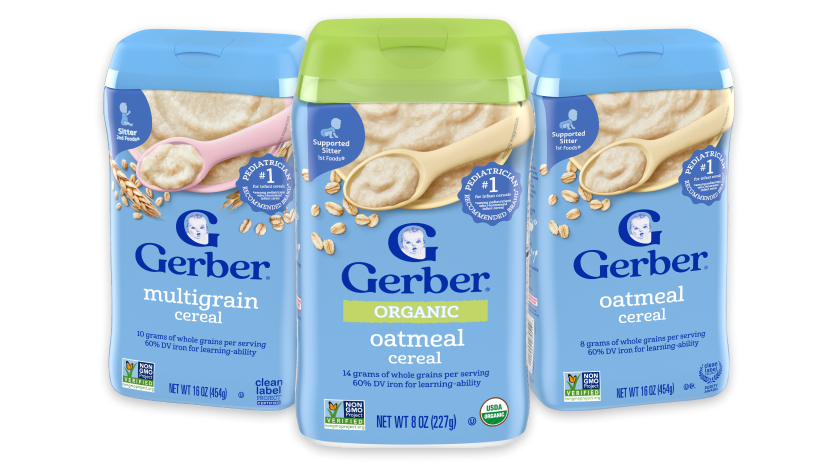
Plain Grain
Supported Sitter, Sitter & Crawler – from starting solids and up
Simple recipes made with just grains and added nutrients for baby’s growth & development while introducing solids.
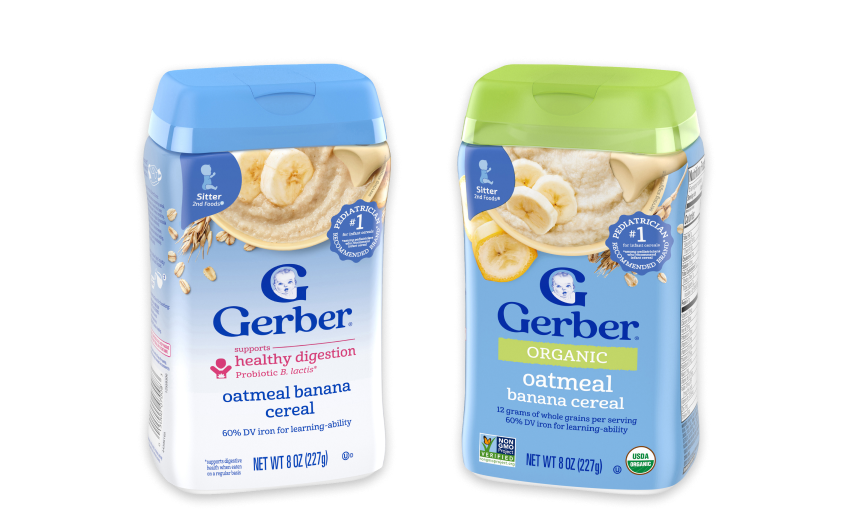
Multi-Grains & Fruits
Sitter & Crawler: From 6+ months
Recipes that diversify baby’s tastes with subtle introduction of flavor & a variety of grains. Select choices offer probiotics.
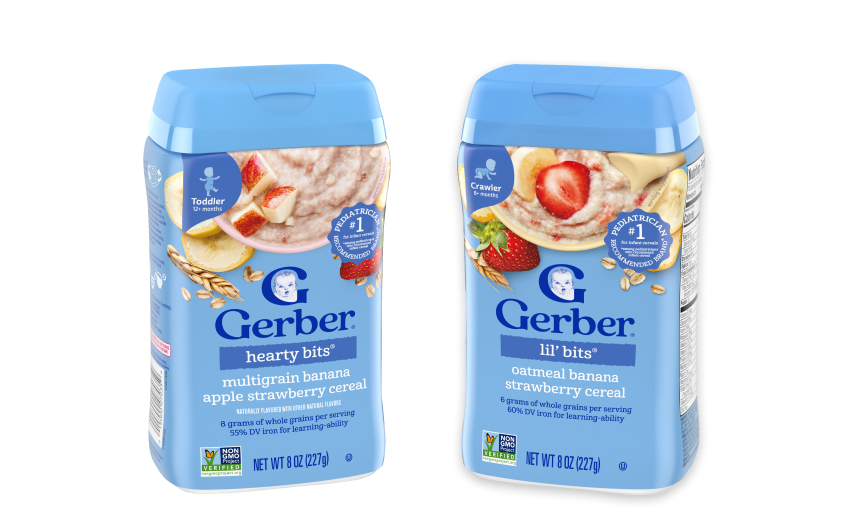
Lil’ Bits® & Hearty Bits®
Crawler & Toddler: From 8+ months
Perfect recipes for older babies and toddlers as they discover new flavors and textures with real fruit flakes and fruit pieces.

Probiotic Cereals
Sitter – from 6+ months
Gerber healthy digestion cereals are formulated with Probiotic B. lactis which supports digestive health when eaten on a regular basis. This recipe boasts 60% DV iron to support learning ability.
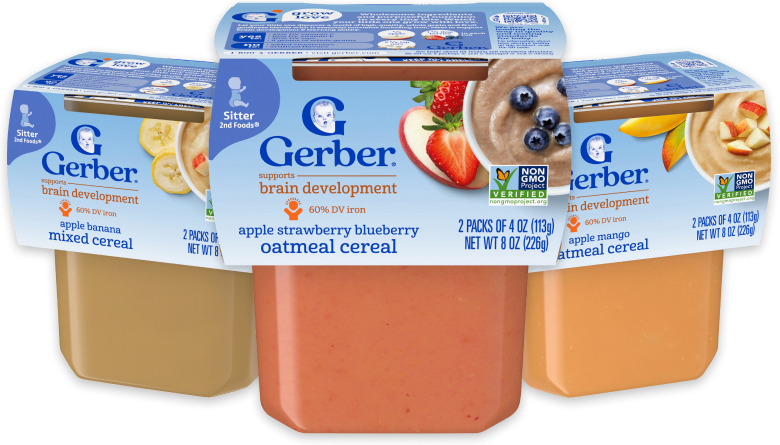
Ready-to-Eat Cereal Purees
Sitter & Crawler: From 6+ months
Gerber Grain & Grow ready to eat cereal purees provide the nutrition of infant cereal in a ready to feed format.
Patient Resources and Practice Tools
Nutrition Assistance Programs

WIC
We are proud to be one of the largest infant food providers to the Supplemental Nutrition Program for Women, Infants, and Children (WIC). Gerber is the only baby food brand approved across all 50 states with options for each category of the WIC Infant Food Package.
View WIC authorized products
CACFP
We’re committed to being your partner in childcare by providing high quality, nutritious foods that meet the Child and Adult Care Food Program (CACFP) Meal Patterns
View CACFP eligible productsCACFP creditable infant products PDF
Related Research and References
FITS data about the importance of infant cereal
96% of breastfed and 70% of partially breastfed infants do not meet dietary iron recommendations when they do not eat iron fortified infant cereal.
20% of fully formula fed infants have a dietary iron intake gap when iron absorption factors are considered. Infant cereal is the top food source of iron for all infants.
12% of WIC infants are not meeting recommendations for dietary iron.
2020-2025 Dietary Guidelines for Americans
Infant cereal is recommended to help breastfed infants meet their iron and zinc needs.
U.S. Department of Agriculture and U.S. Department of Health and Human Services. Dietary Guidelines for Americans, 2020-2025. 9th Edition. December 2020. Available at www.dietaryguidlines.gov
Learn more about the nutrient intakes of breast-fed infants and the role of infant cereal to provide iron and zinc here
Scientific Report of the 2020 Dietary Guidelines Advisory Committee
Dietary Guidelines Advisory Committee 2020
Scientific Report of the 2020 Dietary Guidelines Advisory Committee: Advisory Report to the Secretary of Agriculture and the Secretary of Health and Human Services. U.S. Department of Agriculture, Agricultural Research Service, Washington, DC. Available at: https://doi.org/10.52570/DGAC2020
Read the FDA Closer to Zero Program recommendations for iron-fortified infant cereal for infants 6-12 months
Read the American Academy of Pediatrics guidance for starting solids and the role of foods providing iron and zinc, such as infant cereal.
Answers to Top Parent Questions
What nutrients does one serving of infant cereal provide?
Here is the nutrition in one serving of Gerber Oatmeal Cereal. All varieties of Gerber infant cereals provide the same iron, zinc, and B vitamins as listed here. Note, not all infant cereal brands contain the same level of nutrients.

Can cereal be put in the bottle?
According to the American Academy of Pediatrics, cereal should not be added to a baby’s bottle unless recommended by a pediatrician. Solid foods, including infant cereal should not be fed to babies less than 4 months old, unless medically indicated.
There is no evidence that adding cereal to a baby’s bottle will improve sleep, and this practice could increase the chance of gagging or add unnecessary extra calories to the diet.
Most babies are ready for solid foods around 6 months and at this time, solid foods should not be given in a bottle, unless medically indicated.
What age can parents feed baby cereal?
The AAP and Dietary Guidelines for Americans advise not to start solid foods before four months; most babies are ready around six months. Gerber infant cereals are appropriate for babies starting solids through 12 months and beyond.
How much/how often can I feed my baby cereal?
When first starting foods, offer the 15g serving size of infant cereal. This can be as one serving mixed according to package instructions. Remind parents to follow infant hunger and fullness cues. Once baby is accustomed to eating a variety of foods, keep infant cereal in the diet daily as an important source of iron, zinc, B vitamins and whole grains.
Can families following baby-led weaning use infant cereal for iron?
All babies need iron in the first year – no matter how they are fed – and infant cereal is one of the most versatile sources of iron for infants. Here is how infant cereal fits with a baby-led feeding approach. You can help your patients who are self-feeding get enough iron by sharing these tips:
- Mix infant cereal with less liquid for a thick texture. ¼ cup infant cereal and ¼ cup liquid (breastmilk, formula, or water) result in a texture like mashed potatoes. This texture is ideal for use on a pre-loaded spoon. The caregiver fills or “pre-loads” the spoon, passes it to the child, or puts it on the highchair tray, and the child can self-feed.
- 2 tablespoons of infant cereal provide 3.3mg of iron (30% DV). Stir this amount in other foods baby may be eating, such as purees, yogurt, and pasta sauces, to help favorite foods provide iron.
- Incorporate infant cereal as an ingredient in pancakes, muffins, meatballs (instead of breadcrumbs), and smoothies.
Should babies have rice cereal?
The American Academy of Pediatrics and the FDA Closer to Zero program recommend that infants consume infant cereal to help meet their iron needs but be offered infant cereals made from a variety of grains. Rice cereal does not need to be baby’s first cereal, nor should it be their only variety of infant cereal.
How is Gerber infant cereal different from regular oatmeal?
Gerber baby cereals are designed specifically for the nutrition and development needs of infants.
- Iron: Each 15 g serving of Gerber infant cereal has 60% DV* iron for infants compared to regular oatmeal has 5% DV (unfortified oats**) or 35% DV (fortified oats**) in an equal serving size†. Gerber baby cereals have 60% more iron per serving compared to fortified oatmeal and over 100% more than unfortified oats.
- Vitamin C: Vitamin C is added to support iron absorption (15% DV /serving).
- B vitamins: Gerber fortifies our infant cereals with six B vitamins to support development including brain development.
- Zinc: 30% DV* per serving; Regular oatmeal has 15% DV in an equal serving size†. Gerber baby cereals have 80% more zinc per serving compared to regular oatmeal.
*Iron Daily Value( DV) for infants 6-12 months of age is 11mg; Zinc DV is 3 mg.
†All DVs are reported based on an equal amount of dry cereal – 15g
** Unfortified oats are Old Fashioned and Quick Oats in a traditional cannister; fortified oats are instant oats sold in individual packets.


